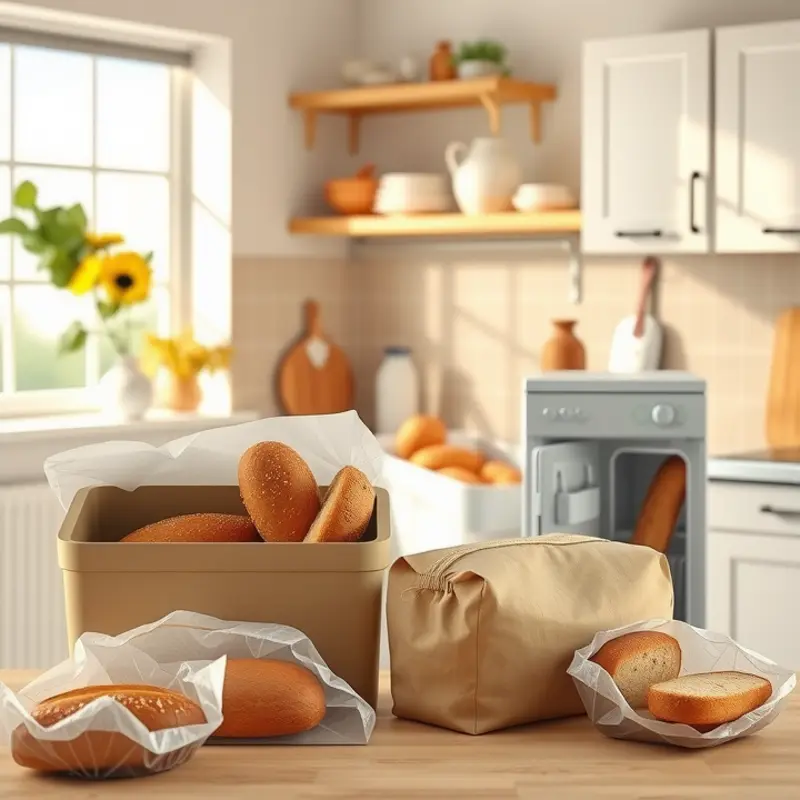Bread is a staple in many households, but improper storage can lead to staleness and waste. Understanding how to store bread effectively can prolong its freshness and minimize food waste. This guide will provide you with clear, actionable tips and techniques to ensure your bread remains delicious and ready to satisfy your cravings.
Choosing the Right Storage Method

Different types of bread call for distinct storage solutions to preserve freshness and flavor. The right method will depend on the bread’s moisture content, crust, and whether it contains preservatives. Let’s delve into moisture control, temperature considerations, and the impact of storage materials.
Moisture control is crucial for bread storage. High-moisture breads, such as sourdough and ciabatta, benefit from allowing some airflow to prevent mold. Storing these in a paper bag within a cool environment can help maintain their crust’s integrity while keeping the interior soft. In contrast, sandwich breads with higher preservative content may fare better in airtight containers to retain their moisture and softness.
Temperature plays a significant role in bread’s shelf life. Room temperature is generally ideal for fresh bread, offering a balance that helps prevent both staleness and spoilage. However, avoid storing bread on top of refrigeration units or other appliances that dissipate heat, as this can expedite staleness. For prolonged storage, freezing is an effective strategy. Ensure the bread is pre-sliced before freezing to make it easier to thaw only what you need. Wrap it tightly in plastic wrap or aluminum foil and place it in a freezer bag to shield it from freezer burn.
Material is another important consideration. A traditional bread box is an excellent choice for hard-crusted breads, as it strikes a balance between breathability and protection from air and moisture. Glass or plastic containers can work well for softer loaves, provided they feature a tight seal. Reusable cloth bags can be a sustainable option, especially if you prioritize eco-friendly practices in your kitchen. This eco-smart kitchen storage guide explores additional sustainable practices you can adopt.
When using plastic bags, which are common for store-bought loaves, inspect the closure. Twist ties or resealable zippers can help maintain freshness. For artisan or homemade loaves not consumed quickly, a double-layer approach—plastic wrap followed by foil—is effective when freezing.
Avoid storing bread in the refrigerator, as the cold temperature accelerates starch crystallization, making bread stale faster, a common misconception detailed in various storage myths. Instead, focus on rotating your stock and consuming fresh bread within a few days. Use older bread for other culinary endeavors, like making croutons or bread pudding, to further reduce waste. Maintaining your bread’s texture and flavor involves not only using suitable storage methods but also understanding the nuances of bread types and the environments in which they are best preserved.
Maximizing Bread Freshness at Home

Bread is inherently sensitive to its surrounding environment, making it vital to consider factors like humidity and air circulation for maintaining optimal freshness. While selecting an appropriate storage method is crucial, understanding and controlling these environmental impacts can enhance bread longevity.
Humidity is the primary culprit accelerating staleness and mold growth. Bread stored in highly humid conditions is prone to mold, while excessively dry environments hasten staleness. Aim for a balanced environment, ideally with a relative humidity around 60%. Consider using a bread bin with a loose-fitting lid to maintain this balance. It allows enough ventilation to prevent excess moisture but protects the bread from drying out. For areas with high humidity, adding a small desiccant pack near the bread can help absorb excess moisture.
Air circulation also plays a pivotal role in bread freshness. While airtight containers seem logical, they can trap moisture, especially for freshly baked bread, accelerating spoilage. Instead, consider a linen interior bread bag that creates a breathable environment, reducing the risk of mold while preventing the bread from becoming stale rapidly.
Practical handling methods can also significantly affect how well bread keeps. Slicing bread only as needed minimizes the exposed surface area, reducing staling risks. Always use a serrated knife for neat cutting, which keeps the loaf intact and maintains optimal structure.
Another efficient strategy is to rotate your bread stock wisely. Position the newest loaves at the back and older ones at the front, ensuring bread is consumed before crossing its freshness pinnacle. Implement a “first in, first out” approach to keep your bread supply fresh.
When it comes to consumption, think about meal planning that integrates bread use efficiently. If a loaf is nearing its end, consider recipes that convert stale bread into new culinary opportunities. Options include transforming stale slices into delightful croutons or breadcrumbs. This not only reduces waste but adds flavorful components to soups and salads. For more low-waste cooking ideas, you can refer to this guide.
To minimize waste, it’s wise to periodically check your bread storage and assess any loaves that require immediate use. Freezing is always an excellent option for preserving bread beyond its typical shelf life. Freeze individual slices, so you can thaw only what is necessary at a time.
In concert with these strategies, maintaining a clean storage environment is imperative. Regularly sanitize storage bins and containers to prevent mold spores from returning. By understanding and managing these environmental factors, you can ensure that your bread remains fresh, delicious, and ready to enjoy.
Final words
Effective bread storage is indispensable for any kitchen. By employing the right methods and understanding the factors that affect freshness, you can greatly reduce waste and enjoy your bread at its best. Whether you choose to store your bread in a specialized container, a simple bag, or even in the freezer, focusing on moisture control and environment will make a significant difference. Remember, the goal is to savor every bite while minimizing what you toss out. With these strategies handy, you can elevate your food management skills and ensure that your bread always meets your needs.







